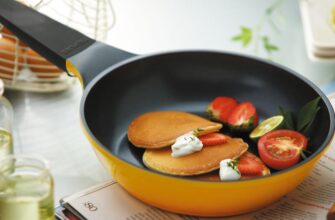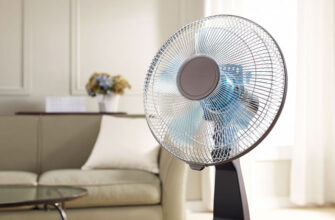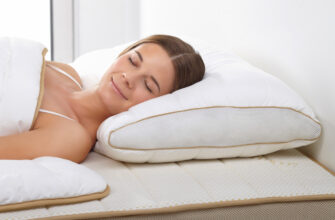To make your kettle convenient to use and not 'die a death of the brave' after several months of use, before buying, pay attention to the material from which it is made, the length of the spout, volume and other parameters. We will tell you how to do this in our article.
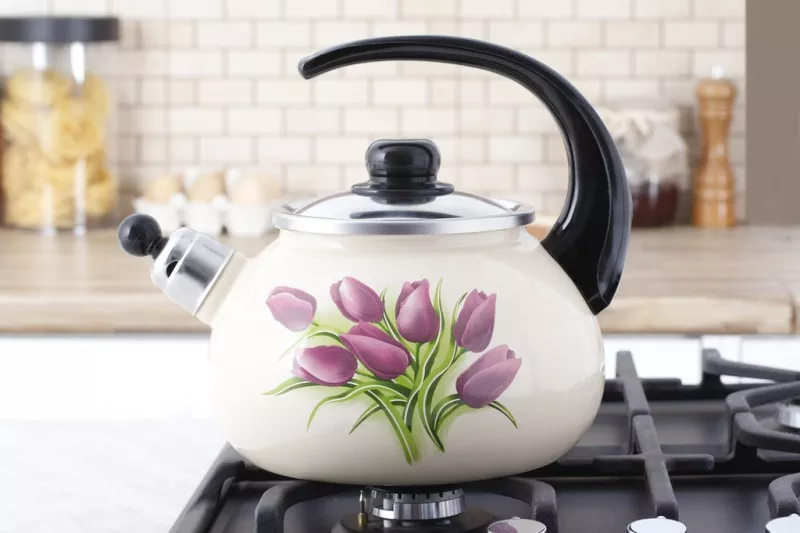
- What are the teapots for the stove
- Stainless steel kettles
- disadvantages
- Aluminum kettles
- disadvantages
- Enamelled steel teapots
- disadvantages
- Glass teapots
- disadvantages
- Cast iron kettles
- disadvantages
- The main criteria for choosing a kettle for the stove
- A pen
- Spout
- Volume
- How to properly wash enamel and stainless steel teapots
- Caring for your enamel teapot
- Care of your stainless steel kettle
- Best stove kettle manufacturers
What are the teapots for the stove
Teapots for the stove are most often made of stainless steel and enamelled steel. Less common on sale are products made of heat-resistant glass, aluminum and ceramics, and cast-iron dishes are almost impossible to find, except at a flea market or in a grandmother's chest. They all have their pros and cons.
Stainless steel kettles

One of the most popular and successful types of teapots. Stainless steel cookware has a beautiful appearance (shiny mirror surface), as well as high strength and resistance to deformation. The stainless steel does not contain any toxic substances that can 'migrate' into the water, so this material is absolutely safe for health.
Many stainless steel models have a 'sandwich' bottom made from other materials such as copper and aluminum. This improves heat distribution and makes the heating of the kettle more even.
Advantages
-
Corrosion resistance – does not rust;
-
Withstand temperature extremes;
-
Suitable for all types of stoves, including induction;
-
High resistance to mechanical damage;
-
Long service life (over 10 years);
-
Simplicity of care;
disadvantages
-
Scale quickly appears on the bottom;
-
Models with thin walls and bottom do not distribute heat well and quickly deteriorate;
-
The surface of the kettle gets dirty quickly;
-
The body of stainless steel dishes gets very hot, you can easily get burned;
Aluminum kettles
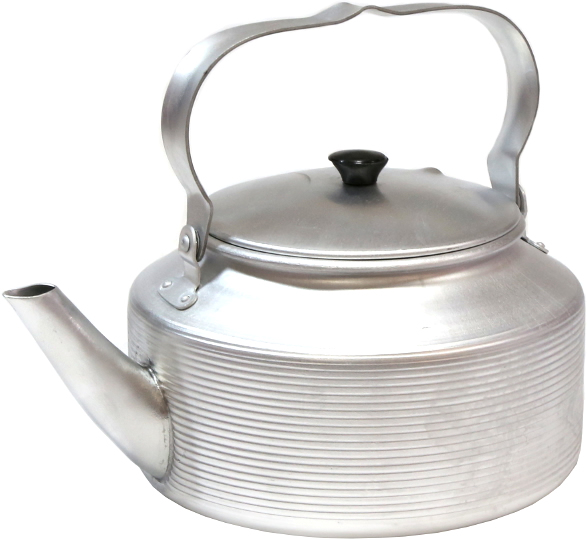
Aluminum is a cheap and lightweight material that resists corrosion. During the Soviet era, it was often used to make pots, cups, cutlery and teapots, but now it is used much less often.
On the Internet, you can find information that aluminum dishes, when heated, release heavy metals into water and food, and they gradually accumulate in our body. This is hazardous to health. an excess of aluminum can lead to the development of diseases such as osteoporosis, cancer, kidney disease, etc.
Others argue that using such utensils for boiling water is safe, because when interacting with oxygen, an oxide film forms on the aluminum surface, which protects drinks from the 'migration' of toxic substances. This film is damaged only by prolonged storage of food and exposure to acids, for example, from tomato juice or sauerkraut. Therefore, the use of an aluminum kettle cannot cause cancer and other diseases.
Unfortunately, it is impossible to say exactly how the use of aluminum cookware affects the human body. Too little research has been done on this issue. Whether it is worth buying such a product is up to you.
Advantages
-
Small weight, even if the kettle is large and thick;
-
Low price;
-
Has a long service life;
-
Does not rust;
-
Heats water quickly;
disadvantages
-
May be harmful to health;
-
Cools down quickly;
-
With a slight physical impact, dents and scratches are formed on it;
-
Changes the taste of water some time after boiling;
Enamelled steel teapots

Enamel teapots are very popular among residents of our country and the CIS countries. The 'fashion' for them began during the Soviet era and continues to this day. And it is not surprising, because they can have a variety of sizes and colors. Thanks to this, the kettle can be matched to any kitchen design. In addition, when heated, such products do not react with water and do not emit hazardous substances.
Advantages
-
Affordable price;
-
Easy to clean;
-
Provides fast water heating;
-
A wide range of;
disadvantages
-
Enamel does not withstand temperature extremes, as a result of which it cracks and breaks off;
-
Scale builds up quickly inside the kettle;
-
Short service life (due to the fragility of the enamel);
-
If the inner enamel coating is damaged, it is better not to use the product – it may release substances hazardous to health;
Glass teapots
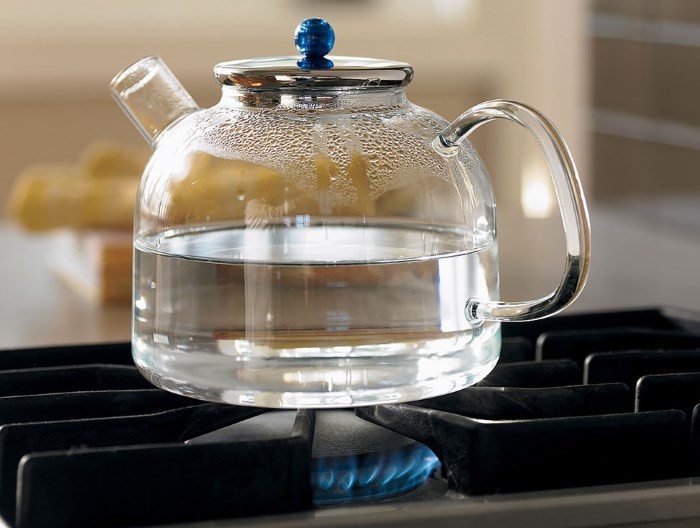
A glass teapot for the stove is a good way to surprise guests. This is a great option for infrequent use and a festive table. But if you boil water in it constantly, the kettle will break faster. The product may also crack if the temperature fluctuates rapidly, for example, if you place a hot kettle under a cold stream of water.
The body of the product is made of fireproof glass, while the lid and handle are made of plastic. Thanks to the transparent walls, you can control the process of boiling water and its level, and plastic reduces the likelihood of burns.
Advantages
-
Beautiful appearance;
-
Easy to clean;
-
Can be heated in the microwave;
-
It is absolutely safe for health, does not emit toxic compounds and does not change the taste of water;
disadvantages
-
High fragility of glass – even with a slight impact, the walls can crack;
-
Not suitable for permanent use;
-
Poorly withstands temperature changes;
Cast iron kettles

Cast iron teapots are one of the most durable and reliable options. They are difficult to scratch or deform, and their service life is tens of years. These teapots warm up evenly and cool down slowly. During long gatherings, you do not have to constantly boil the water – it will remain hot for a long time.
Advantages
-
Durability;
-
Withstand strong temperature changes;
-
High strength and resistance to mechanical stress;
disadvantages
-
Large weight;
-
Rarely on sale;
-
Water heats up for a long time;
-
Cast iron cookware can rust;
The main criteria for choosing a kettle for the stove
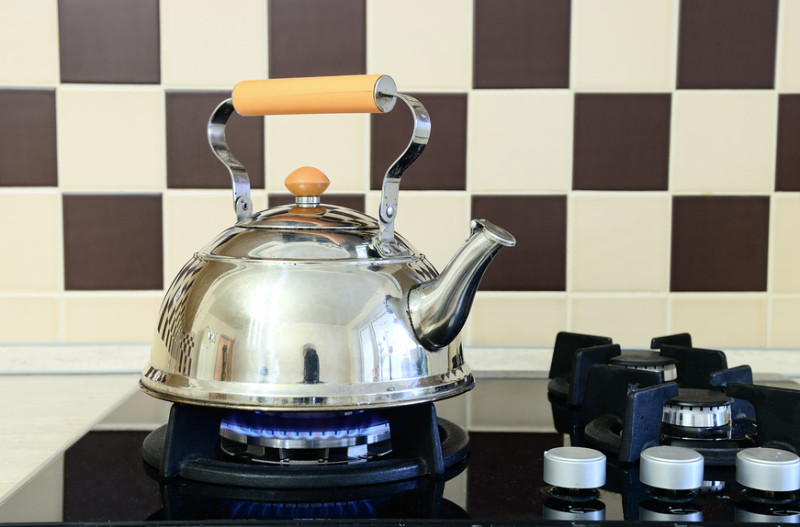
A pen
When buying a kettle, be sure to pay attention to the material from which the handle is made. If it has a low thermal conductivity, it will save you from burns.
Handles can be made from:
-
Bakelite;
-
Metal;
-
Ceramics.
Bakelite is a heat-resistant material designed for temperatures up to 180C. Above 180C it begins to char, so it should be kept away from fire. Bakelite handles are comfortable to use, they do not slip and are pleasant to the touch.
Enamel teapots are usually equipped with metal or ceramic handles. Metal handles are very hot, but they are highly durable and resistant to impacts and drops, while ceramic handles are very fragile. They slowly heat up, but if the kettle is not removed from the stove in time, you can burn yourself on them.
Sometimes kettles are equipped with silicone handles. Silicone has low thermal conductivity and can withstand temperatures up to 230C.
Spout
With a kettle with a small and wide spout, you can quickly fill your cup. However, a lot of liquid should not be poured into it – the water level should not be higher than the lowest point at which the spout and the body of the kettle are connected. If you use a product with a narrow and long spout, the water flow will be slower. Also, if you tilt the kettle too much, boiling water may spill out from under the lid.
Volume
The volume of the kettle can be either 0.7 liters or 3.2 liters. The choice of displacement, first of all, should depend on the number of people who will drink tea. For example, for a festive table or a large company, choose models for 2-3 liters, and for a family of four, dishes for 1.5-2 liters are suitable. A teapot with a volume of 0.7 liters is enough for one person, and one liter for a couple in love.
How to properly wash enamel and stainless steel teapots
Improper care of the kettle not only shortens the life of the product, but can also harm human health. For example, the use of abrasive cleaners and harsh sponges will thin the enamel coating on the cookware, causing it to crack and chip, and the kettle must be thrown away. If a person continues to use such a kettle, the 'open' metal reacts with water and releases substances that are hazardous to health.
Caring for your enamel teapot
Before using the product for the first time, temper it. Boil water and salt in it (1 tablespoon of salt per 500 ml of water). This will make the coating more durable.
Enamel teapots are prone to limescale deposits. To prevent its formation, clean the inside of the kettle with a soft sponge daily. Do not use strong detergents or hard sponges (brushes). Do not leave water in the kettle for long.
You can use citric acid, baking soda, vinegar, and even potato peels to get rid of the limescale. Most often, housewives use citric acid. To wash off scale, you must:
-
Fill the kettle with a solution of water and citric acid at the rate of 25 g per 2.5 liters;
-
Boil the solution and immediately remove from heat;
-
Wait until the liquid has cooled;
-
Rinse under running water and remove limescale residues with a sponge.
-
Do not wash a hot kettle in cold water. Enamel may crack due to sudden temperature changes.
Care of your stainless steel kettle
Stainless steel dishes quickly get dirty, and stains instantly appear on them. Therefore, it should be washed regularly with mild detergents or laundry soap. It is not recommended to use harsh sponges and abrasive cleaning agents – they can scratch the surface. For stubborn and old stains, you can use baking soda and soap. For this:
-
Rinse the kettle under running water;
-
Lather the sponge with soap and sprinkle with baking soda on top;
-
Sprinkle baking soda over the kettle;
-
Wipe the product with a sponge with the prepared mixture;
-
After 40-60 minutes, wash the dishes in warm water;
-
Repeat as necessary.
Best stove kettle manufacturers
The quality of the kettle, the safety of the coating and its service life depend on the manufacturer. Buying cookware from an unknown brand can not only lead to unnecessary expenses, but also harm your health.
Some manufacturers make cookware from low-quality materials that quickly deform and the coating chipping off, allowing the metal to react with water and release compounds that are hazardous to health. In addition, some budget models of teapots have too thin walls and bottom, which is why they heat up unevenly and quickly deteriorate, and the 'heat-resistant' handle heats up and melts.
To reduce the risk of a failed purchase, look at the following manufacturers:
-
Rondell;
-
Bekker;
-
Vinzer;
-
Bork;
-
Esprado;
-
Wellberg.
These manufacturers are very popular among residents of the Russian Federation, CIS countries and Europe. Most of the reviews about the teapots of these companies are positive – consumers report high quality dishes, durability and ease of use.
!
In the following articles, our experts tell you how to choose the right electric kettle, the secrets of choosing a bread machine and recommendations for choosing a Turkish coffee.
Attention! This material is the subjective opinion of the authors of the project and is not a purchase guide.




